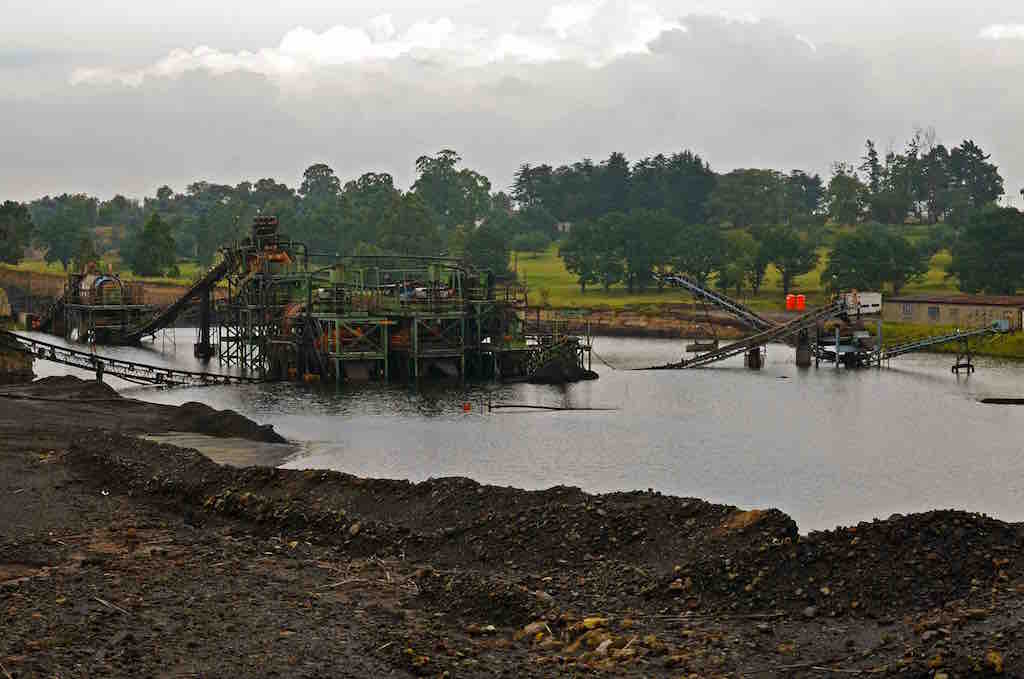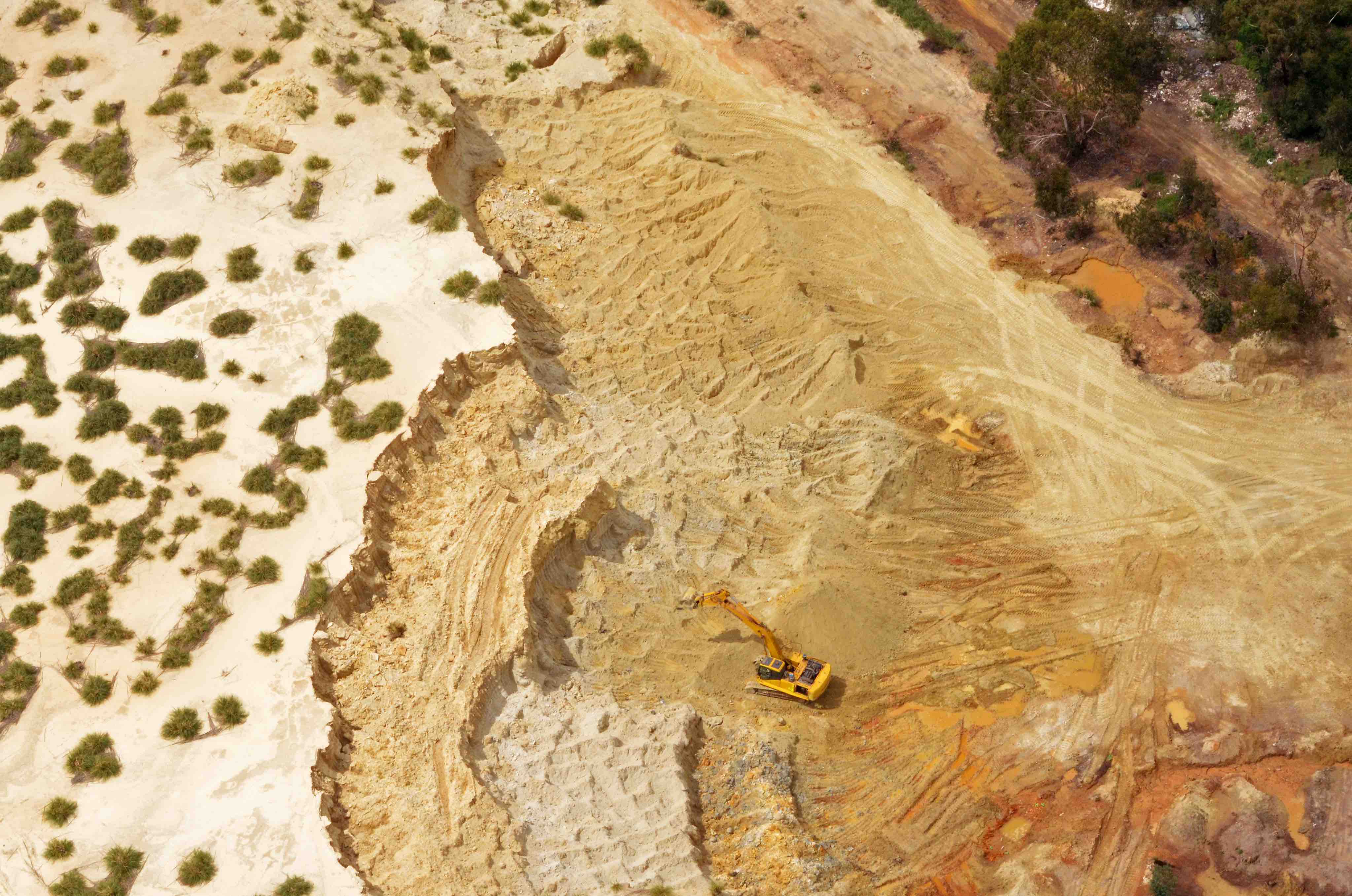
17 May Sweeping water permit violations at mines across SA
New data reveals a radical increase in the number of mines flouting water regulations. Mark Olalde & Andiswa Matikinca investigate

A miner uses a high pressure water cannon to blast rock at a gold mine near Johannesburg. Photo: Mark Olalde
New statistics released in Parliament show 118 mines around South Africa are polluting local rivers, inadequately testing for contamination or otherwise dirtying South Africa’s waterways.
Figures released by Minister of Water and Sanitation Gugile Nkwinti also show that 115 mines are known to be operating without a proper water licence in place. This represents a significant increase from 2014, when the South African Human Rights Commission found 39 mines in noncompliance.
Violators are spread across every province and include major corporations such as AngloGold Ashanti, De Beers, Glencore and Anglo American Platinum.
In response to parliamentary questions posed by MP Anton Alberts from Freedom Front Plus, the minister released the data showing that during 2017/18 more than 15% of the 712 mines licensed to use or to impact water sources had failed to comply with the water use permits stipulating the conditions of the usage.
Asked what steps are taken to address the deficiencies, the minister responded: “It is not clear why transgressors resort to operation of mines without the requisite authorisation; however, the department continues to intensify activities to protect the water resources as mandated by the National Water Act… The department investigates identified as well as reported non- compliances regularly.”
Alberts told Oxpeckers Investigative Environmental Journalism that he had referred the list of transgressions, which covers 2015 to 2018, to the department’s Blue Scorpions regulatory unit. This is the group tasked with finding offenders who break water laws, and fining them.
“Even though mines are a part of our economy, we need to find a balance between just getting the profits out of the ground and leaving nature spoiled and people who live there becoming sick,” Alberts said.

John Mthembo, a member of the Vukani Environmental Justice Movement in Action, displays a bucket of water from a township heavily polluted by dust from a nearby coal mine and coal-fired power station in Mpumalanga in 2017. Photo: Mark Olalde
Coalfields impacts
The data set released by the minister was compiled by the Department of Water and Sanitation and uncovered a wide range of permit violations: polluted water discharged directly into the environment, waste piles contaminating groundwater, unlined waste water retention ponds, oil spills, insufficient monitoring, excessive dewatering of the underground void and inadequate record-keeping.
As climate change continues to worsen South Africa’s water security, the mining industry’s number of water-related infractions is rising. In 2017/18, the department found 10 more mines significantly out of compliance with their water use permits than the year before and 38 more than in 2015/16.
Much of the mining industry’s impact is in the coalfields of Mpumalanga and Limpopo, which ranked first and second, respectively, in the number of mines out of compliance with their water use licences.
Saul Roux, science and policy specialist at the Centre for Environmental Rights, said acid mine drainage poses mining’s largest threat to clean water resources. Coal mining on the Highveld overlaps with significant portions of the country’s 22 designated strategic water source areas, which provide 60% of all South Africans with water.
“Our scarce water resources are impacted throughout the coal life-cycle, including direct impacts on water quality during coal mining, impacts of air pollutants on water resources and coal ash contamination of groundwater,” Roux said.

Abandoned mining equipment left flooded at an Anker Coal and Mineral Holdings South Africa mine in 2017. Photo: Mark Olalde
Company responses
The companies’ responses to the data depicted disorganisation in the government bureaucracy that polices them. The department only had 35 compliance and enforcement officials to cover the entire country in recent years, according to a report by the South African Water Caucus, a group of NGOs and unions set up to study water use.
The data listed elevated levels of pollutants at Glencore’s Mpumalanga mines, for instance, but company spokesperson Lerato Setsiba said the department had not informed the company of the infractions.
“Glencore has an extensive water monitoring network on all sites where water qualities are measured on a monthly basis and investigations are conducted on any exceedance of water quality,” Setsiba said in a statement.
Other large major mining companies also defended their infractions.
Anglo American Platinum’s spokesperson, Jana Marais, responded to the findings that several of its mines, including the Twickenham Platinum Mine in Mpumalanga, discharged polluted water. She said the company was spending millions of rand to upgrade water infrastructure at the Twickenham mine and that an external audit had found higher compliance with water permits than the department found.
Chris Nthite, AngloGold’s representative, said the company was aware of listed violations, which included waste spillages, stormwater management issues and unauthorised water use, and had addressed them. “[AngloGold] has offered measures to remedy any problem, or has not been contacted further,” he said.
The department’s spokesperson, Sputnik Ratau, did not respond to requests for comment on why the department allowed mining companies to continue operating with outstanding infractions. Ayanda Shezi from the Department of Mineral Resources also did not comment, instead referring questions back to the Department of Water and Sanitation when asked about potential inter-agency cooperation in the policing of mining companies.

A miner operates heavy machinery at a gold mine on the West Rand. Photo: Mark Olalde
Court action
With water pollution continuing unchecked, environmental activists have taken to the courts in an attempt to protect water resources in both the coalfields and gold-mining basins.
Mariette Liefferink, chief executive of the Federation for a Sustainable Environment, told Oxpeckers her group is in the process of filing litigation against the ministers of water and sanitation and of minerals, among other parties, for their role in the environmental catastrophe unfolding at the Mintails SA gold mines on the West Rand.
A parliamentary inquiry revealed late last year that the government allowed mining to continue at Mintails after mine waste spilled into nearby waterways, that unfunded environmental liabilities topped R460-million and that children drowned in open mining pits.
Mintails was less than 25% compliant with its water use licence in 2015/16, according to the recent data released in Parliament. Mining at the operations near Krugersdorp have largely halted, as the company is liquidated and proceeds flow back to investors in London.
“There is a significant lack of political will, which means polluters can continue with impunity to ignore directives,” Liefferink said. – oxpeckers.org
This investigation was published by the Mail & Guardian here. Reporting was sponsored by #MineAlert and the Open Society Foundation for South Africa
• Find the data set of non-compliances and transgressions here and the list of non-compliant mines here
Post-publication update: The De Beers Group pointed out it no longer owns Finsch Mine. The operation was sold to Petra Diamonds as a going concern in 2011 – and at the time of the sale, the water licence was intact, according to spokesperson Jackie Mapiloko.
She said Namaqualand Mines has a number of water uses which are covered under three water licences (Water Use Certificate 25007171, Water Use Certificate 2502668 and Water Exemption 899B), which are all currently active.
